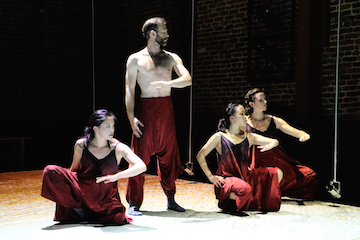
Liss Fain Dance describes its production Your Story Was This as “an immersive performance installation.” That doesn’t give us a sense of how central dance is to the work, but it does reveal the importance of the audience and the theater space to this carefully crafted dance piece.
Your Story Was This was a co-presentation of ODC Theater and its premiere took place in ODC’s small and attractive theater on 17th Street. Essentially a brick black box, with its lighting rig discreetly placed on the edges of the “stage”, the theater has an openness that is made more solid in both time and space by the masonry that comprises its exterior walls.
On the stage’s black floor, two large rectangles of gray Marley were taped down at angles to each other. Above, in the fly space, rectangles of semi-transparent cloth hung, bent into right angles, and defining an upper “stage” that also surrounded the sources of the light projected onto the Marley, which was the performance area for the dancers. The viewers were invited to sit anywhere within the black spaces. They were also encouraged to move around, through the spaces that rim the performance rectangles. Only a few audience members made use of the opportunity.
However, simply bringing the viewer onto the same plane as the dancers changes the experience. The piece allows for “immersion” – short of entering into the dance itself.
Dancing in the round provides a peculiar and difficult challenge to the choreographer. And indeed, during the performance Fain moved around the space watching the dancers as their focus changed and their movements shifted direction.
The dancers were four: Aidan DeYoung, Katharine Hawthorne, and sisters Megan and Shannon Kurashige. One man and three women. And their kinetic relationships were defined by height, rather than gender. An abstract and a geometric minimalism was maintained in the lines connecting the dancers: in their entwining of limbs and bodies.
It was modern dance, for sure. Though not precisely barefoot. Nor Graham. But with an emphasis on balanced, slow and sustained movement. Very demanding over time, and for 45 minutes the dancers were constantly on stage, constantly dancing even while standing statue-like and still. Moments of maenad movements broke the otherwise measured choreography.
All this – set, choreography, and lights – was set almost oppositionally to the voice-over that rose now and again in the ambient-like music, with its touches of sounds from the natural world.
The poems read were short poems from the work of Jane Hirschfield, including “A Cottony Fate,” “China” and “It Was Like This: You Were Happy.” Poems that describe the difficulties of human love and interaction. The language is accessible, but pared down. Like the lights and draped cloth, simple and clean.
“Migrations, internal and physical, are the root of the choreography,” say Fain’s program notes. Fair enough. Certainly the four excellent dancers were able to imbue their movement with an intensity that resonated with the impulses that compel migration, the leaving of one home for another in an insecure future. Or the risk necessary for love.
– Jaime Robles
Photo: Liss Fain Dance presents “Your Story Was This,” with dancers Aidan DeYoung, Katharine Hawthorne, and sisters Megan and Shannon Kurashige. Photo by Benjamin Hersh.
